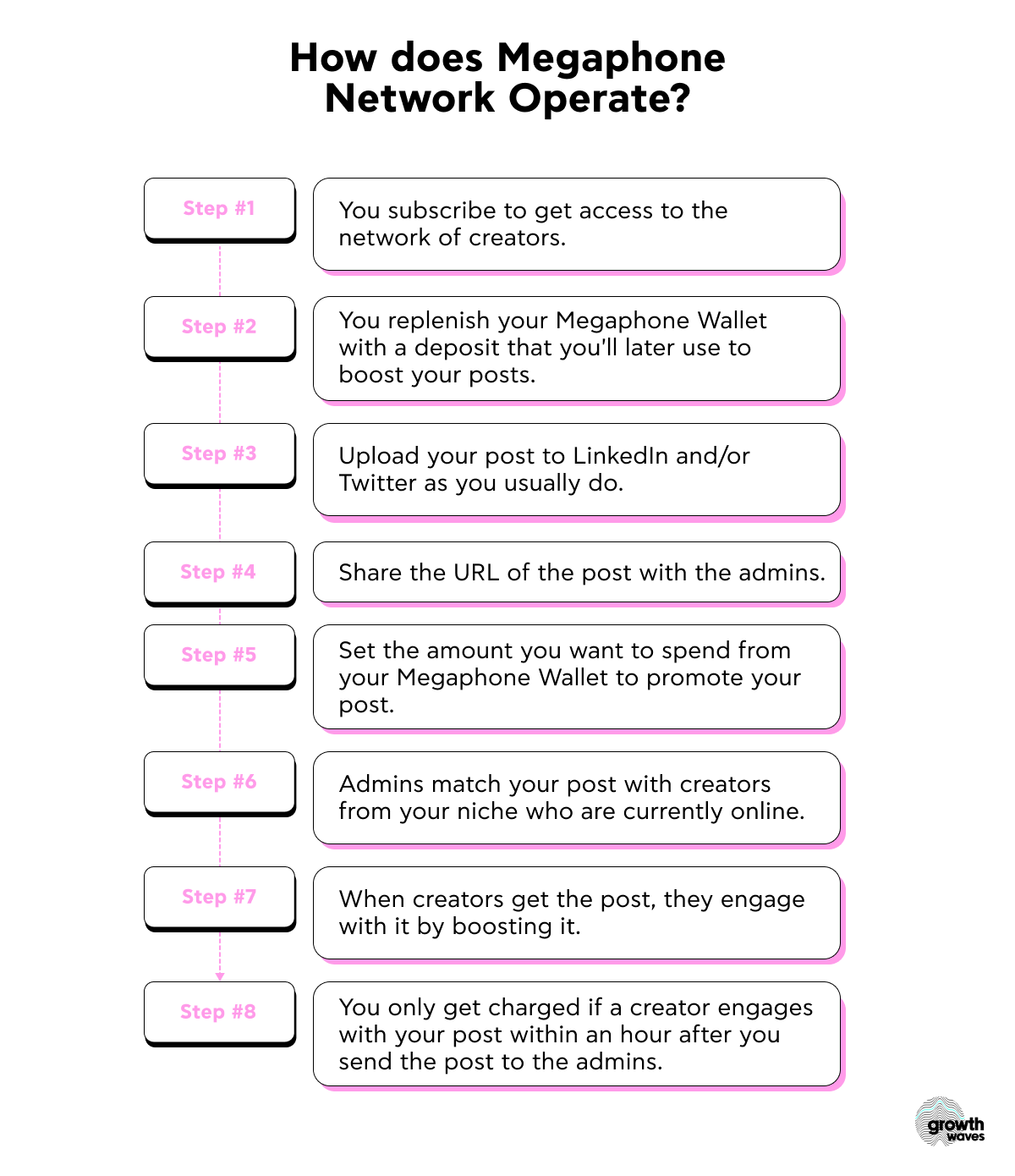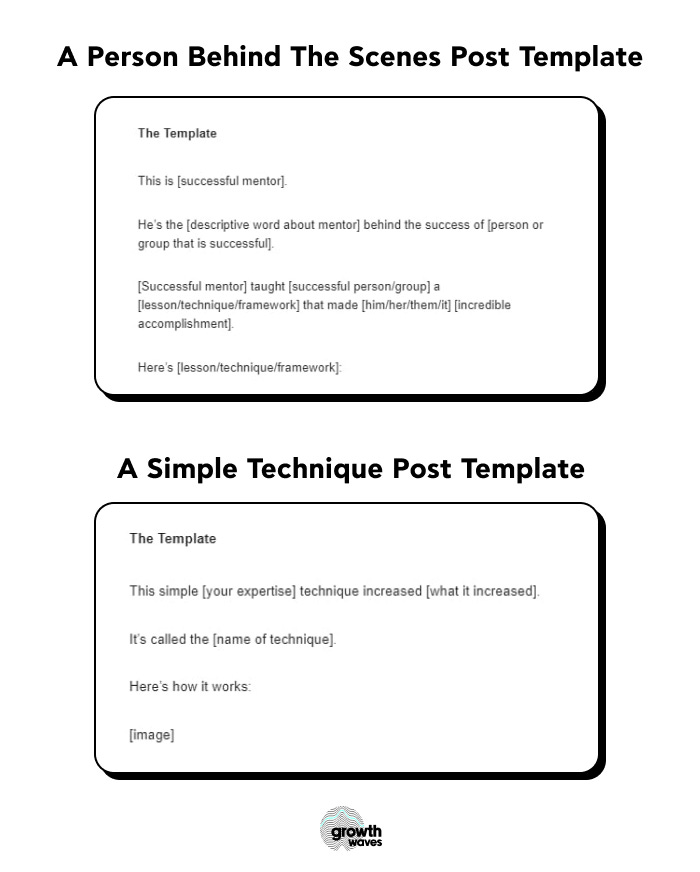That's how you create power users
The two-part formula for going viral: What Megaphone got right
👋 Hey, I’m George Chasiotis. Welcome to GrowthWaves, your weekly dose of B2B growth insights—featuring powerful case studies, emerging trends, and unconventional strategies you won’t find anywhere else.
What does it mean to go viral?
The first thing that comes to mind is getting lots of engagements.
But not just any engagements.
What you really want is attention from the right people.
And you want to get it with high-quality content that truly speaks to them.
Megaphone, the company we’ll focus on in today’s Note, found a way to cover both ingredients of going viral:
Creating content worthy of being shared
Getting engagements from the right audience
How?
Keep on reading.
Key findings
Here are the top insights from today’s research:
Megaphone launched less than a year ago. Since its inception, it has already managed to attract 250 creators and 502 signups, generate 53 million impressions for its users, and help them get over 416K followers collectively.
The platform helps your LinkedIn and X posts get engagements from legit creators. Megaphone has a database of vetted influencers who can boost your content for a price you set.
Megaphone also supports its users in creating viral content. For this purpose, the platform’s founder created Viral Examples, a weekly newsletter.
Now, let’s dive into the specifics.
Megaphone’s backstory: A short timeline and how it works
Megaphone is an online network-like platform that helps facilitate the growth of your X and LinkedIn accounts through boosts from other creators in your niche.
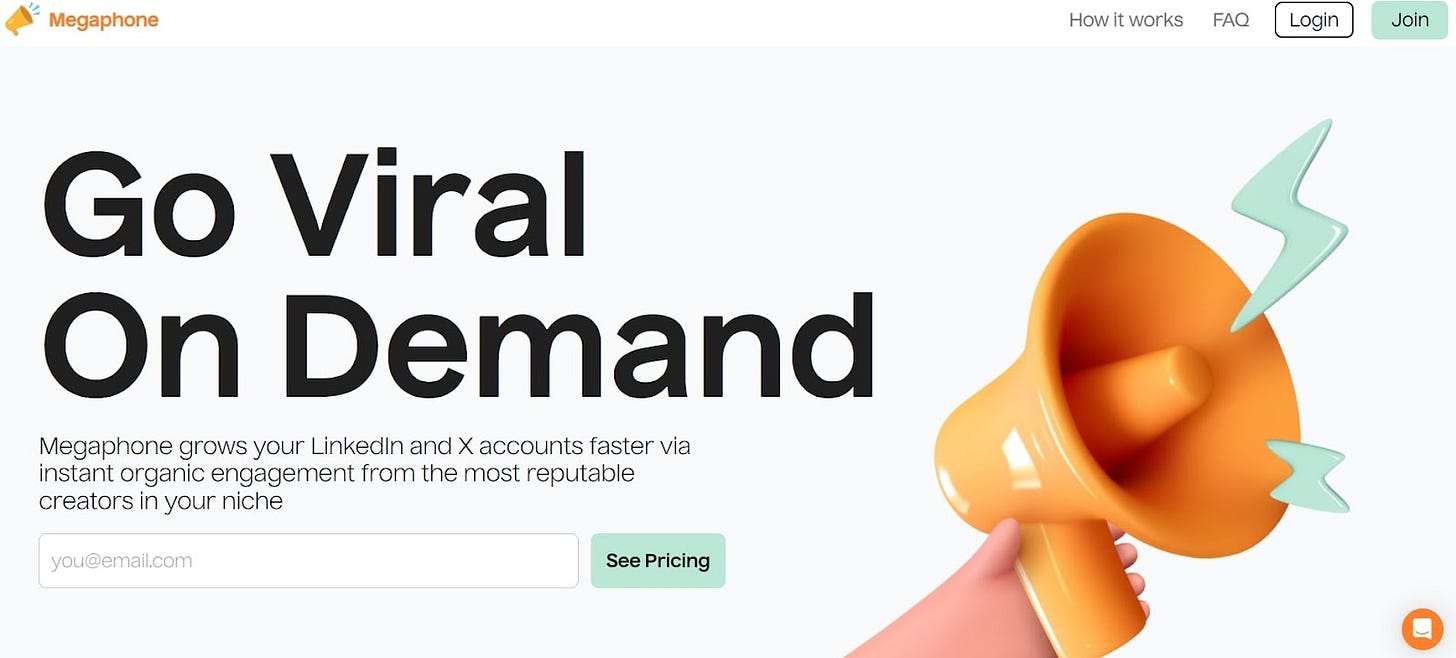
Although Megaphone launched less than a year ago (in August 2023), the company has already hit some notable growth milestones.
Take a look.
Quite an interesting case, as you can see.
But how did Megaphone come to be?
The company’s founder, Michael Houck, developed the idea for the company based on the insight he learned while growing his X and LinkedIn profiles.
As he shared in his interview for the Proof of Work podcast:
“The dirty secret of social media is that 90% of big creators that you know became big creators because other big creators were their friends and helped them grow early on by commenting on and engaging with their stuff.”
He meant that there was an idea of so-called closed communities only for a selected few who either knew or were referred by popular niche influencers and thus had more chances of getting promoted.
He reiterated this idea to Yaniv Bernstein and Chris Saad of The Startup Podcast.
“All these big creators that you see, they have their WhatsApp group chats, Telegram group chats, iMessage group chats, where they share posts and give each other advice on content. But most importantly, when the poster shares (content), they go in, they comment on it, they like it, maybe they retweet it, whatever the case may be. That’s happening everywhere, in every niche.”
The intent behind Megaphone was to bring such interactions between creators out of the shadow, i.e., make them official.
But how does it work exactly?
Let me explain.
The mechanism behind Megaphone
If we zoom out and look at Megaphone from a broader perspective, it pursues a very specific goal.
To help you go viral on demand.
This goal becomes evident when you take a closer look at how Megaphone works.
Below is a detailed description of how to use the platform to boost your LinkedIn or X post.
We can break this process down into two parts.
First, there are actions required from you:
Subscribe
Replenish the Megaphone Wallet
Share the URL of the post
Indicate the amount to be paid for a post-boost
Regarding the last point, you decide how much you are ready to spend.
According to Michael’s comment during the episode of Venture with Grace podcast:
“Most people spend between $20 and $30 to boost a post, and that gets you engagements from a few creators in most cases.”
The second part of the process is under the control of Megaphone’s algorithm:
It matches your post with niche creators who are currently online.
They have one hour since you shared the post URL to promote your content.
You only get charged if the influencer engages with your post.
Are these creators real people?
In the video on Megaphone’s homepage, Michael Houck explains the following:
“Creators can’t join Megaphone without a referral from an existing creator, and I personally vet everyone who joins the network.”
So yes, all the engagements come from living, breathing niche influencers.
But these engagements aren’t enough to go viral.
Content quality contributes to virality
Indeed, with Megaphone, you can “purchase” extra visibility for your content on LinkedIn and X.
However, there’s a limit to buying your way through virality.
“The engagement of the amplification is only one half of the battle,” Michael Houck told the hosts of the above-mentioned The Startup Podcast.
The other half is content quality, which Michael knows like no other (given his experience growing his X and LinkedIn following to over 90K).
So, to share his knowledge and provide actionable support in creating high-quality content for the above platforms, Michael launched a spin-off project called Viral Examples.
Let’s see what it is about.
What is Viral Examples?
Viral Examples is a weekly newsletter by Megaphone covering three posts on LinkedIn and X that received high engagement.
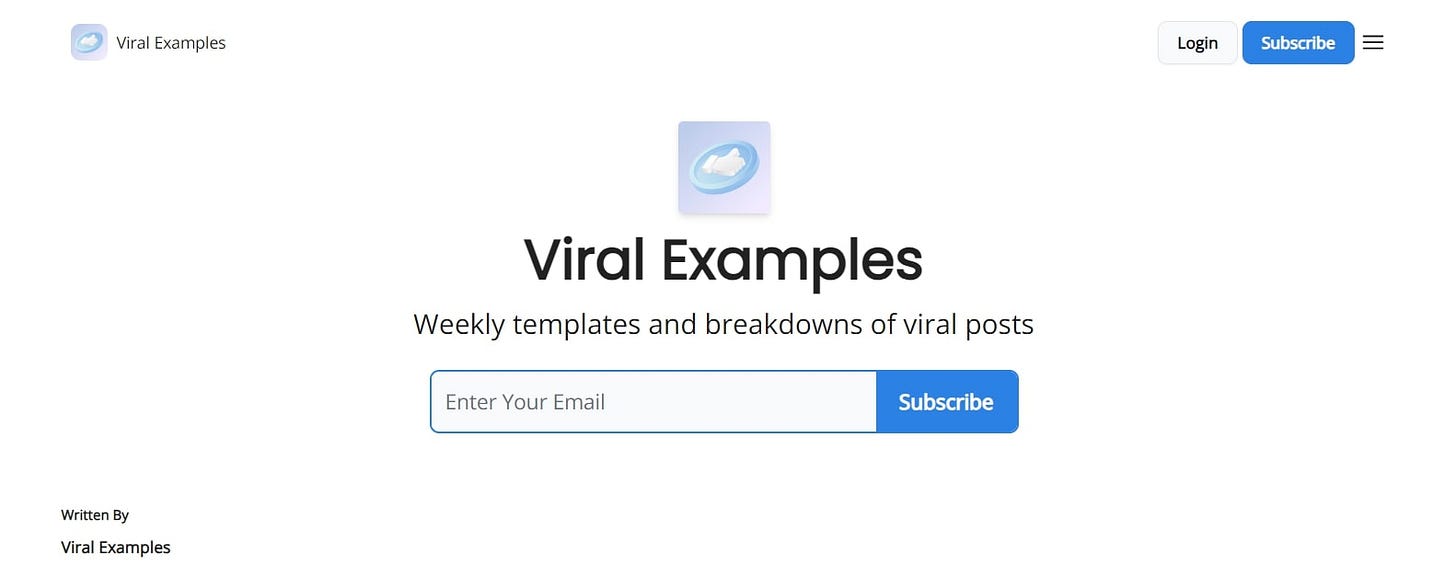
The newsletter is hosted on beehiiv and written by Michael Houck and Max Palmer, Chief of Staff at Houck’s Newsletter (Michael’s other project).
The first issue went live on beehiiv on 18 April 2024, with new ones coming out every Thursday (with a one-time exception).
Now, what does a standard issue of Viral Examples look like?
How does it help achieve the newsletter’s goal of helping you grow faster on X and LinkedIn?
Let’s analyze its structure to answer these questions.
Viral Examples: newsletter structure and purpose
Each new Viral Examples newsletter issue contains the following:
Three posts from LinkedIn and X.
The analysis of why they resonated with people.
The templated version of each analyzed post.
The authors’ own example of using the templated versions.
Here’s what this structure looks like in real life.
Editor’s Note: For demonstration purposes, I used the first post example from the second issue of the Viral Examples newsletter.
Let me break it down a bit.
Typically, a newsletter issue starts with an intro stating the newsletter’s goal—to help the reader grow on X and LinkedIn.
Each example of a post receives its own title based on its function.
For instance, in the example above, we have a Counterintuitive Advice post, similar in style to contrarian content.
The other two posts in the second newsletter issue give inspiration for:
“A person behind the scenes” content.
“A simple technique” post.
This way, the newsletter gives a unique name to each template.
Next, we have a short analysis of the post, which normally consists of two points explaining why it has collected so many engagements.
This is done to justify why a post template could work for others striving to grow on X and LinkedIn.
Then, based on the post example, the authors generate a template anyone can copy and reuse.
Here are the templates for the other two posts from the newsletter’s second issue.
Finally, to further clarify how someone can use these templates, the authors provide their own examples.
With this newsletter structure, the authors achieve the following objectives:
Inspire the readers with viral content ideas
Give a logical reason behind the content’s virality
Make it simple to repeat the same success
Apart from weekly newsletter issues, Michael and Max created a database of high-performing LinkedIn and X posts on Airtable for those looking for more inspiration.
This database includes:
URLs of post examples
Names of creators
Platform
Type of post
Engagement metrics: views, likes & bookmarks, reposts & quotes, and replies
Media (images, videos)
Publishing date
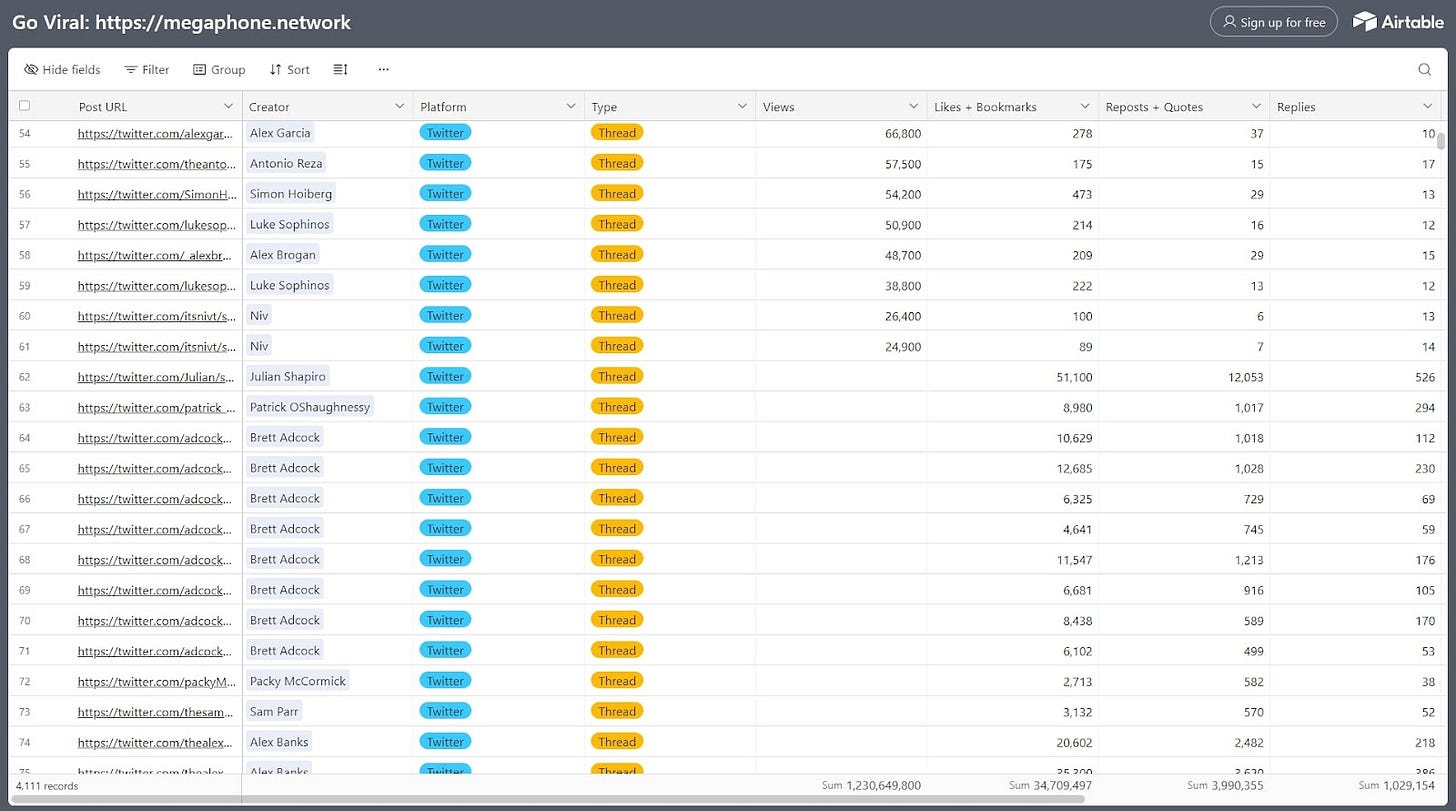
What lacks, in my opinion, is a categorization of all the posts by template titles used in the newsletter issues.
Nevertheless, together with weekly newsletter issues, this database creates a supportive go-to resource on:
What content drives the most engagement on LinkedIn and X.
How to apply this knowledge in practice.
So, the value of Viral Examples for its readership is clear.
But what does Megaphone get out of it?
Conclusion
With Viral Examples, Megaphone closes the cycle, so to speak.
On the one hand, its platform that enables on-demand content promotion helps cover one part of going viral: boosting visibility.
On the other hand, through the Viral Examples newsletter, Megaphone educates its customers on what content is more prone to get noticed on X and LinkedIn.
Such a well-rounded approach creates power users who get the most out of Megaphone’s product and can leverage it for efficiency.
A great strategy to build trust with your customers, don’t you agree?
Thank you for reading today’s GrowthWaves Note.
See you in two weeks!



